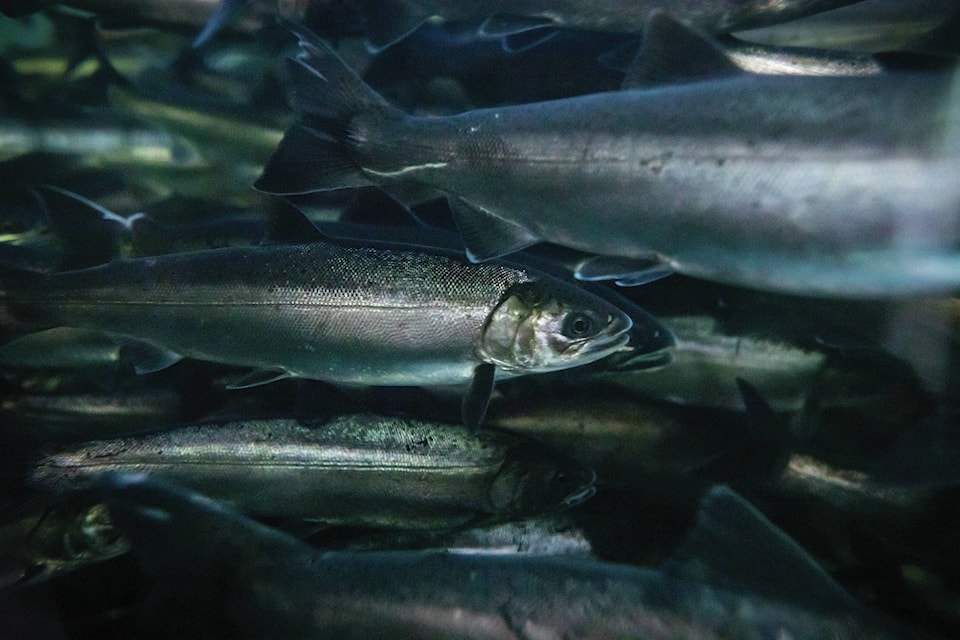CLINTON, B.C. — The federal government has announced new restrictions to recreational and First Nations fishing of chinook salmon in British Columbia after a significant rock slide on the Fraser River.
The slide is in a remote area near Big Bar, northwest of Kamloops in the Interior, and has created a five-metre waterfall that is blocking all but a small percentage of chinook salmon from migrating upstream to spawn.
The measures announced Friday represent an “unquestionably difficult” decision in terms of the impacts on First Nations communities and on recreational fish harvesters, said Andrew Thomson, a regional director with the Department of Fisheries and Oceans.
“The potential for permanent loss of these chinook populations represents a greater threat to the livelihoods of all those who depend on salmon for sustenance and economic opportunity as well as for the wildlife that depend on them as a food source,” he said.
Thomson said the department will implement a new maximum size limit of 80 centimetres for chinook retention in all the areas of the province where chinook fishing was set to open on July 15.
He said the measure will help avoid impacts on larger at-risk Fraser chinook that are having greater success migrating past the rock slide area. He said the decision will be reassessed at the end of July.
The department is working with First Nations to minimize chinook harvests above the slide site in order to ensure the maximum possible number of chinook that managed to pass through the barrier successfully reach their spawning grounds, Thomson said.
The measures fall short of what some First Nations and conservation groups had called for.
Grand Chief Stewart Phillip, president of the Union of BC Indian Chiefs, said his group fully supports a call from the Fraser Salmon Management Council to immediately stop all recreational and commercial Fraser River salmon fisheries.
“The Big Bar rock slide is an extreme crisis for our sacred salmon and we have a responsibility to look after them,” he said in a news release.
Thomson said the department wanted to take a balanced approach that protected chinook while still allowing recreational harvest to open up July 15.
The federal department and the B.C. government have been at the site since late June assessing the impact and trying to find a solution. They’ve installed acoustic monitoring equipment to get a sense of how many salmon are impacted because the muddy, turbulent water makes it difficult to count.
Experts are considering a number of options, including reducing the height of the falls or providing passage for fish through engineering and rock work. Another option would be moving the fish by truck from below the slide to above it, but the area is remote and has little road access.
Several salmon populations that use the river are already in peril and their numbers would severely decline if they are unable to spawn, said Aaron Hill, executive director of the Watershed Watch Salmon Society.
He noted the obstruction is fairly close to the start of the long and winding river, so it’s affecting a large part of the Fraser watershed and major tributaries, which are used by dozens of important salmon populations to spawn.
“People and wildlife depend on those salmon all the way from the West Coast to up into the Northern Interior and out to the Rocky Mountains,” he said. “Further depletion of those salmon runs will have a profound impact.”
Vincent Bryan, an innovator behind a possible solution known as a “salmon cannon,” said the problem is urgent because the fish will start arriving en masse in August and by the middle of that month there will be a million or more sockeye backed up.
Asked how soon a fix was needed, he replied, “Last week.”
Bryan’s Washington-based company, Whooshh Innovations, has created a flexible, pressurized tube that moves fish over obstructions and he’s been at the rock slide site assessing how the system could work there.
He said a barge with the salmon passageway mounted on top would be placed on a relatively calm eddy, attracting fish to the reprieve from turbulent waters.
“Once they’re into the system, they’re going to be transported in about 20 seconds about (150 metres) upstream and back into the river,” he said.
Work was delayed last week by heavy rain that made the water more choppy and raised safety concerns, he said.
